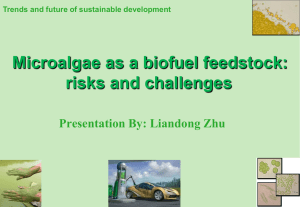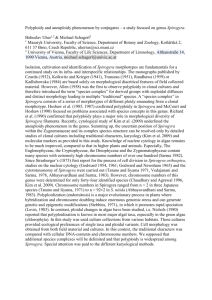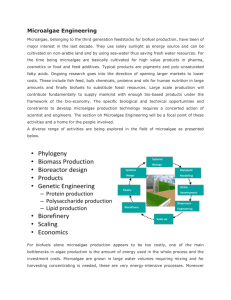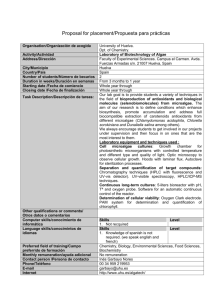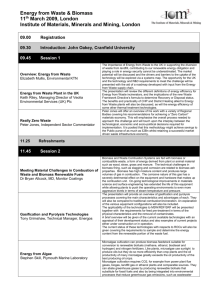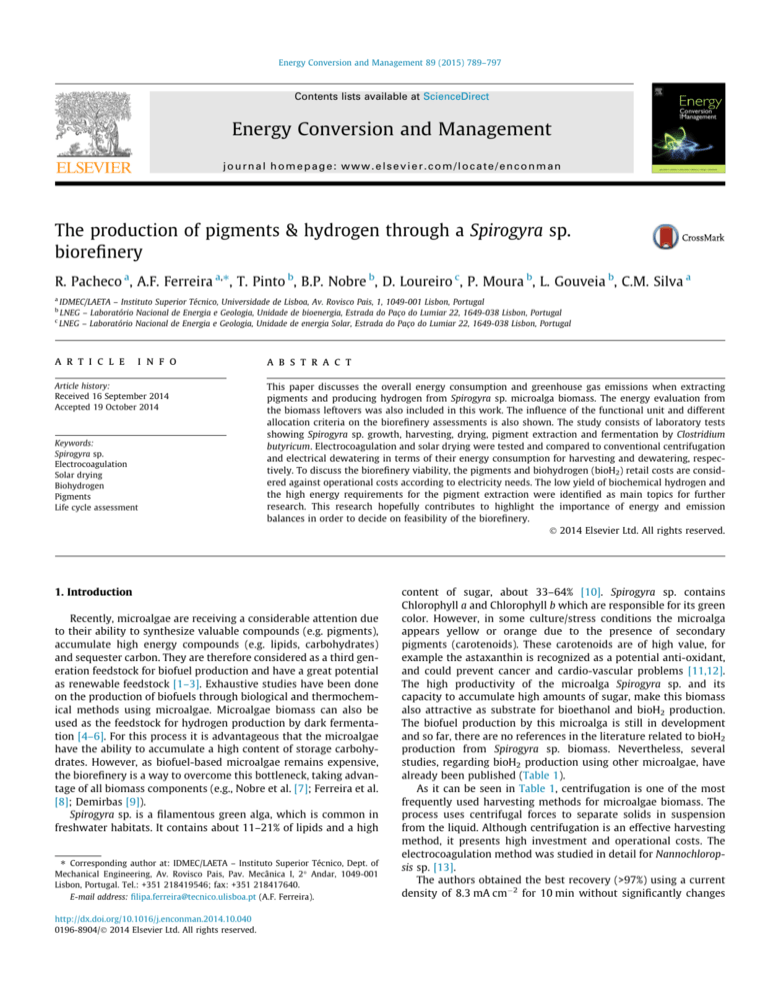
Energy Conversion and Management 89 (2015) 789–797
Contents lists available at ScienceDirect
Energy Conversion and Management
journal homepage: www.elsevier.com/locate/enconman
The production of pigments & hydrogen through a Spirogyra sp.
biorefinery
R. Pacheco a, A.F. Ferreira a,⇑, T. Pinto b, B.P. Nobre b, D. Loureiro c, P. Moura b, L. Gouveia b, C.M. Silva a
a
IDMEC/LAETA – Instituto Superior Técnico, Universidade de Lisboa, Av. Rovisco Pais, 1, 1049-001 Lisbon, Portugal
LNEG – Laboratório Nacional de Energia e Geologia, Unidade de bioenergia, Estrada do Paço do Lumiar 22, 1649-038 Lisbon, Portugal
c
LNEG – Laboratório Nacional de Energia e Geologia, Unidade de energia Solar, Estrada do Paço do Lumiar 22, 1649-038 Lisbon, Portugal
b
a r t i c l e
i n f o
Article history:
Received 16 September 2014
Accepted 19 October 2014
Keywords:
Spirogyra sp.
Electrocoagulation
Solar drying
Biohydrogen
Pigments
Life cycle assessment
a b s t r a c t
This paper discusses the overall energy consumption and greenhouse gas emissions when extracting
pigments and producing hydrogen from Spirogyra sp. microalga biomass. The energy evaluation from
the biomass leftovers was also included in this work. The influence of the functional unit and different
allocation criteria on the biorefinery assessments is also shown. The study consists of laboratory tests
showing Spirogyra sp. growth, harvesting, drying, pigment extraction and fermentation by Clostridium
butyricum. Electrocoagulation and solar drying were tested and compared to conventional centrifugation
and electrical dewatering in terms of their energy consumption for harvesting and dewatering, respectively. To discuss the biorefinery viability, the pigments and biohydrogen (bioH2) retail costs are considered against operational costs according to electricity needs. The low yield of biochemical hydrogen and
the high energy requirements for the pigment extraction were identified as main topics for further
research. This research hopefully contributes to highlight the importance of energy and emission
balances in order to decide on feasibility of the biorefinery.
Ó 2014 Elsevier Ltd. All rights reserved.
1. Introduction
Recently, microalgae are receiving a considerable attention due
to their ability to synthesize valuable compounds (e.g. pigments),
accumulate high energy compounds (e.g. lipids, carbohydrates)
and sequester carbon. They are therefore considered as a third generation feedstock for biofuel production and have a great potential
as renewable feedstock [1–3]. Exhaustive studies have been done
on the production of biofuels through biological and thermochemical methods using microalgae. Microalgae biomass can also be
used as the feedstock for hydrogen production by dark fermentation [4–6]. For this process it is advantageous that the microalgae
have the ability to accumulate a high content of storage carbohydrates. However, as biofuel-based microalgae remains expensive,
the biorefinery is a way to overcome this bottleneck, taking advantage of all biomass components (e.g., Nobre et al. [7]; Ferreira et al.
[8]; Demirbas [9]).
Spirogyra sp. is a filamentous green alga, which is common in
freshwater habitats. It contains about 11–21% of lipids and a high
⇑ Corresponding author at: IDMEC/LAETA – Instituto Superior Técnico, Dept. of
Mechanical Engineering, Av. Rovisco Pais, Pav. Mecânica I, 2° Andar, 1049-001
Lisbon, Portugal. Tel.: +351 218419546; fax: +351 218417640.
E-mail address: filipa.ferreira@tecnico.ulisboa.pt (A.F. Ferreira).
http://dx.doi.org/10.1016/j.enconman.2014.10.040
0196-8904/Ó 2014 Elsevier Ltd. All rights reserved.
content of sugar, about 33–64% [10]. Spirogyra sp. contains
Chlorophyll a and Chlorophyll b which are responsible for its green
color. However, in some culture/stress conditions the microalga
appears yellow or orange due to the presence of secondary
pigments (carotenoids). These carotenoids are of high value, for
example the astaxanthin is recognized as a potential anti-oxidant,
and could prevent cancer and cardio-vascular problems [11,12].
The high productivity of the microalga Spirogyra sp. and its
capacity to accumulate high amounts of sugar, make this biomass
also attractive as substrate for bioethanol and bioH2 production.
The biofuel production by this microalga is still in development
and so far, there are no references in the literature related to bioH2
production from Spirogyra sp. biomass. Nevertheless, several
studies, regarding bioH2 production using other microalgae, have
already been published (Table 1).
As it can be seen in Table 1, centrifugation is one of the most
frequently used harvesting methods for microalgae biomass. The
process uses centrifugal forces to separate solids in suspension
from the liquid. Although centrifugation is an effective harvesting
method, it presents high investment and operational costs. The
electrocoagulation method was studied in detail for Nannochloropsis sp. [13].
The authors obtained the best recovery (>97%) using a current
density of 8.3 mA cm2 for 10 min without significantly changes

